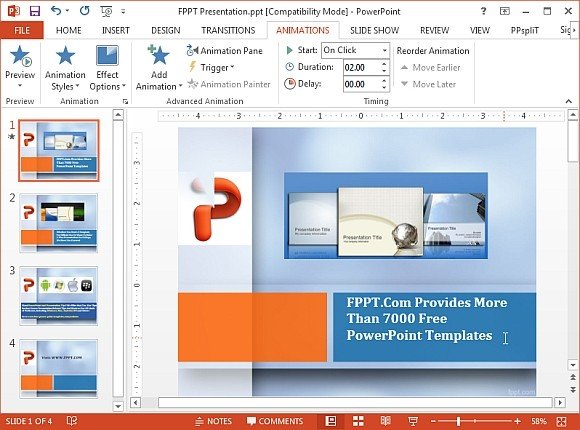

Click the Down Arrow to the right of the effect listing.Select an animation effect from the list.
How to add animation in powerpoint presentation how to#
How to set the start time and duration of an effect Select either the up and down arrow, next to the Play From button, to move the animation earlier or later in the sequence.Select the Animation you wish to move in the Animation pane.Select the Animation pane from the Advanced Animation group.Click the Animations tab in the navigation ribbon.With a bit of imagination, the PowerPoint shape tool will be all you need to create a great bug habitat.How to change the order of the animation effects Now add a background scene to complete your slide. Now that you’ve got those legs moving in a suitably bug-like manner, make sure that all the leg animations are set to “With Previous”, so that they move at the same time as the body. You may need to play around with how many repeats you need on this animation, depending on how long you set the duration of the motion path (you want the legs to be moving the whole time that the body is moving). We went for 0.4s, but you can modify at your leisure. You’ll also need to change the duration of the spin animation, since bug legs move quickly. In the timings tab, select the number of times you wish the animation to repeat from the “Repeat” drop-down menu (we went for 10). We want the spin animation to repeat, so that the legs move back and forth a number of times whilst the body is moving. Now navigate to the Timings tab, in that same dialog box. Whilst you’re in the Effects dialog box, make sure you check the “Auto-reverse” option too – this makes sure the legs move backwards as well as forwards. We went for 9°, but it depends how noticeably you want the legs to rotate. To change this, right click the animation in the Animation Pane, select “Effect Options”, and change the degree rotation in the custom box from the “Amount” drop down menu. The default for a spin animation is a 360° clockwise turn…which is not how bug legs behave. To do this, make sure you have the leg selected, navigate to the Animation ribbon, select “Add Animation”, and choose “Spin” from the Emphasis effects. To make the legs more lifelike, we’re going to add a Spin animation to get them to rotate slightly, otherwise the bug will just look like he’s sliding across the screen. Select the bug, use the shortcut, then click the legs to copy the animation over. You can use the incredibly handy Animation Painter to do this – the shortcut for which is Alt+Shift+C. Copy the motion path onto each of the legs. Step 7: Buckle up – this is the slightly more complicated part. You can play around with the duration of your animation (on the right hand side of the Animation ribbon) too, in case you want to make your bug scuttle more menacingly across the screen (or take it’s time, which somehow is equally gross). Click the body, navigate to the Animation ribbon, and add a motion path. Step 5: Bring the bug’s body to the front ( Arrange > Bring to front). Step 4: Line up each leg so that it fits onto the bug’s body. Group each leg with its corresponding invisible box. Step 3: Make the boxes invisible by getting rid of the fill colour ( Format > Shape Fill > No fill) and outline ( Format > Shape Outline > No outline). Send the boxes to the back ( Arrange > Send to back) so that you can see the legs on top of each box, and position the end of each leg so that it sits in the centre of its box. To do this, simply draw a box around each leg (hold down Ctrl + Shift as you click and drag to draw the box, and this will ensure it stays symmetrical and in perfect proportion). Since the legs of the bug are going to spin slightly as it crawls, we are going to need to put invisible boxes around each leg. Step 2: In PowerPoint, if you want to make a non-symmetrical object spin about a specified point, you need to attach it to a symmetrical object (otherwise it will spin willy-nilly and look rather strange). Make sure each leg is in its own group, and the antennae and body are also grouped together. To shape the legs into something more bug-like than just straight lines, try grouping 2-3 lines together (you can do this using the shortcut Ctrl+G, or choosing Arrange > Group from the Home ribbon at the top). Add in the antennae and legs using the line tool. Here, we’ve drawn two circles for the head and body, then used the Union tool ( Format > Merge shapes > Union) to combine the two circles into one shape. You can use the “ Insert shape” and Boolean tools in PowerPoint to get creative. Maybe you’re sat at your desk, a blank slide open, and you think to yourself, “You know what the world needs more of? Animated PowerPoint bugs.” Good job you’re here – this is just the article for you. In PowerPoint, you can create pretty much anything you put your mind to, with just a few tricks up your sleeve and a bit of animation know-how.


 0 kommentar(er)
0 kommentar(er)
